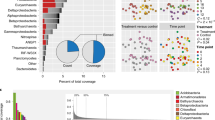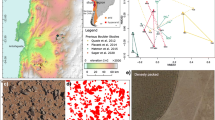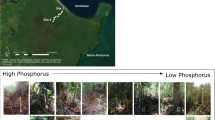Abstract
The majority of biomass in the McMurdo Dry Valleys of Antarctica occurs within rocks and soils, but despite the wealth of biodiversity data very little is known about the potential functionality of communities within these substrates. The putative physiological capacity of microbial communities in granite boulders (chasmoendoliths) and soils of a maritime-influenced Antarctic Dry Valleys were interrogated using the GeoChip microarray. Diversity estimates revealed surprisingly high diversity and evenness in both communities, with Chlorobi and Deinococci in soils accounting for major differences between the substrates. Autotrophs were more diverse in chasmoendoliths, and diazotrophs more diverse in soils. Both substrates revealed a previously unappreciated abundance of Halobacteria (Archaea), Ascomycota (Fungi) and Basidiomycoyta (Fungi). The fungi accounted for much of the differences between substrates in metabolic pathways associated with carbon transformations, particularly for aromatic compounds. Nitrogen fixation genes were more common in soils, although nitrogen catabolism genes were abundant in chasmoendoliths. Stress response pathways were more diverse in chasmoendoliths, possibly reflecting greater environmental stress in this exposed substrate compared with subsurface soils. Overall diversity of stress-tolerance genes was markedly lower than that recorded for inland locations where environmental stress is exacerbated. We postulate that the chasmoendolithic community occupies a key role in biogeochemical transformations in Dry Valley systems where granite substrates are abundant among open soils. The findings indicate that a substantial upward revision to estimates of biologically active surfaces in this system is warranted.




Similar content being viewed by others
References
Arenz BE et al (2006) Fungal diversity in soils and historic wood from the Ross Sea region of Antarctica. Soil Biol Biochem 38:3057–3064
Bahl J et al (2011) Ancient origins determine global biogeography of hot and cold desert cyanobacteria. Nat Commun 2:163. doi:10.1038/ncomms1167
Bottos E et al (2013) Airborne bacterial populations above desert soils of the McMurdo Dry Valleys, Antarctica. Microb Ecol 67:120–128
Caruso T et al (2011) Stochastic and deterministic processes interact to determine global biogeography of arid soil bacteria. ISME J 5:1406–1413
Cary SC, McDonald IR, Barrett JE, Cowan DA (2010) On the rocks: the microbiology of Antarctic Dry Valley soils. Nat Rev Microbiol 8:129–138
Chan Y et al (2012) Hypolithic microbial communities: between a rock and a hard place. Environ Microbiol 14:2272–2282
Chan Y et al (2013) Functional ecology of an Antarctic dry valley. Proc Natl Acad Sci USA 110:8990–8995
Clarke KR (1993) Non-parametric multivariate analyses of changes in community structure. Aust J Ecol 18:117–143
Cowan DA et al (2011) Distribution and abiotic influences on hypolithic microbial communities in an Antarctic dry valley. Polar Biol 34:307–311
de La Torre J, Goebel B, Friedmann EI, Pace NR (2003) Microbial diversity of cryptoendolithic communities from the McMurdo Dry Valleys, Antarctica. Appl Environ Microbiol 69:3858–3867
de los Rios A, Wierzchos J, Sancho LG, Ascaso C (2004) Exploring the physiological state of continental Antarctic endolithic microorganisms by microscopy. FEMS Microbiol Ecol 50:143–152
de los Rios A et al (2005) Endolithic growth of two Lecidea lichens in granite from continental Antarctica detected by molecular and microscopy techniques. New Phytol 165:181–190
de los Ríos A, Wierzchos J, Sancho LG, Ascaso C (2007) Ultrastructural and genetic characteristics of endolithic cyanobacterial biofilms colonizing Antarctic granite rocks. FEMS Microbiol Ecol 59:386–395
Doran PT et al (2002) Valley floor climate observations from the McMurdo Dry Valleys, Antarctica, 1986–2000. J Geophys Res 107(D24):4772. doi:10.1029/2001JD002045
Elbert W et al (2012) Contribution of cryptogamic covers to the global cycles of carbon and nitrogen. Nat Geosci 5:459–462
Fay P (1992) Oxygen relations of nitrogen fixation in cyanobacteria. Microbiol Rev 56:340–373
Fraser CI et al (2014) Geothermal activity helps life survive glacial cycles. Proc Natl Acad Sci USA 111:5634–5639
Friedmann EI (1982) Endolithic microorganisms in the Antarctic cold desert. Science 215:68–74
Friedmann EI, Kibler AP (1980) Nitrogen economy of endolithic microbial communities in hot and cold deserts. Microb Ecol 6:95–108
Friedmann EI, Kappen L, Meyer MA, Neinow JA (1993) Long-term productivity in the cryptoendolithic community of the Ross Desert, Antarctica. Microb Ecol 25:51–69
He Z et al (2007) GeoChip: a comprehensive microarray for investigating biogeochemical, ecological and environmental processes. ISME J 1:67–77
Lee CK et al (2012) The inter-valley soil comparative survey: the ecology of Dry Valley edaphic microbial communities. ISME J 6:1046–1057
Maghales C et al (2012) At limits of life: multidisciplinary insights reveal environmental constraints on biotic diversity in continental Antarctica. PLoS One. doi:10.1371/journal.pone.0044578
Ng KW, Pointing SB, Dvornyk V (2013) Patterns of nucleotide diversity in the idpA circadian gene in closely related species of cyanobacteria from extreme cold deserts. Appl Environ Microbiol 79:1516–1522
Niederberger TD et al (2012) Diverse and highly active diazotrophic assemblages inhabit ephemerally wetted soils of the Antarctic Dry Valleys. FEMS Microbiol Ecol 82:376–390
Pointing SB, Belnap J (2012) Microbial colonization and controls in dryland systems. Nat Rev Microbiol 10:551–562
Pointing SB et al (2007) Hypolithic community shifts occur as a result of liquid water availability along environmental gradients in China’s hot and cold hyperarid deserts. Environ Microbiol 9:414–424
Pointing SB et al (2009) Highly specialized microbial diversity in hyper-arid polar desert. Proc Natl Acad Sci USA 106:19964–19969
Pointing SB, Bollard-Breen B, Gillman LN (2014) Diverse cryptic refuges for life during glaciation. Proc Natl Acad Sci USA 111:5452–5453
Rao S et al (2011) Low-diversity fungal assemblage in an Antarctic Dry Valleys soil. Polar Biol 35:567–574
Scientific Committee on Antarctic Research (2004) SCAR Bulletin #155. Polar Rec 40:371–382
Thomas DSG (1997) Arid zones: their nature and extent. In: Thomas DSG (ed) Arid zone geomorphology, 2nd edn. Wiley, Chichester, pp 3–12
Wierzchos J, de los Rios A, Ascaso C (2013) Microorganisms in desert rocks: the edge of life on Earth. Int Microbiol 15:171–181
Wong KY et al (2010a) Hypolithic colonization of quartz pavement in the high altitude tundra of central Tibet. Microb Ecol 60:730–739
Wong KY et al (2010b) Endolithic microbial colonization of limestone in a high-altitude arid environment. Microb Ecol 59:689–699
Wynn-Williams DD (1990) Ecological aspects of Antarctic microbiology. Adv Microb Ecol 11:71–146
Yung C et al (2014) Characterization of chasmoendolithic community in Miers Valley, McMurdo Dry Valleys, Antarctica. Microb Ecol 68:351–359
Zhou J et al (2008) Spatial scaling of functional gene diversity across various microbial taxa. Proc Natl Acad Sci USA 105:7768–7773
Acknowledgments
This study was funded by the Institute for Applied Ecology New Zealand. The development of the GeoChip and associated computational pipelines used in this study was supported by Ecosystems and Networks Integrated with Genes and Molecular Assemblies (ENIGMA) through the US Department of Energy (DE-AC02-05CH11231). J. Zhou and J. D. Van Nostrand’s efforts were supported by the US Department of Energy (DE-SC0004601) and the US National Science Foundation (EF-1065844). The authors are extremely grateful to Antarctica New Zealand for logistics and field support in Antarctica.
Author information
Authors and Affiliations
Corresponding author
Rights and permissions
About this article
Cite this article
Wei, S.T.S., Fernandez-Martinez, MA., Chan, Y. et al. Diverse metabolic and stress-tolerance pathways in chasmoendolithic and soil communities of Miers Valley, McMurdo Dry Valleys, Antarctica. Polar Biol 38, 433–443 (2015). https://doi.org/10.1007/s00300-014-1598-3
Received:
Revised:
Accepted:
Published:
Issue Date:
DOI: https://doi.org/10.1007/s00300-014-1598-3




